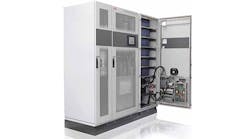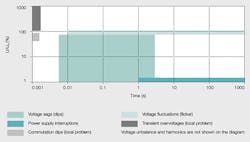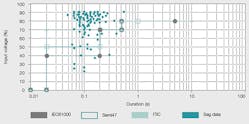With industry's rapidly increasing automation, the current DIN standard EN 50160 [1] defining quality characteristics of supply voltages based on European minimum requirements can no longer be considered adequate for modern sophisticated plants. This is a growing issue as production equipment becomes more sensitive and more vulnerable to deviations from these minimum requirements.
Problems in electrical networks
There are various voltage problems that can occur in electrical networks. These include transient overvoltages, voltage sags, flicker (periodically occurring voltage fluctuations), voltage imbalance, voltage harmonics and supply interruption. Voltage sags (also referred to as voltage dips), are characterized by amplitudes below 90 percent of the nominal voltage, and represent the most frequent power quality problem. A voltage sag involves a reduction of the RMS (root mean square) voltage, associated with a particular waveform shape, characterized by its duration and the remaining voltage ➔ 1.
1 Typical duration and remaining voltage of different voltage problems [2]
Although the main causes of voltage sags are atmospheric disturbances such as lightning and thunderstorms, faults and switching events in the grid can also lead to short-term sags. According to statistics from the Electric Power Research Institute (EPRI), more than 92 percent of all voltage sags exhibit a depth of between 10 percent and 30 percent and a duration of less than 1s. The depth and duration of a voltage sag depend on many factors such as the local network characteristics (meshing, impedances and grounding), the voltage level of the occurring fault, the fault distance, the loads and their undervoltage behavior, etc.
In the industrial world, voltage sags may have consequences such as injury to persons, wasted material, long restart times, machine disturbances or defects, extensive repair or maintenance activities, costly service actions, lower production qualities, revenue losses or contractual penalties. The costs of such events can quickly amount to several hundred thousand dollars, especially in continuously producing industries such as the semiconductor, automotive or chemical industries.
Power supply integrity issues
The decisive factor determining what protection measures are necessary is the sensitivity of the load. Some entities, such as the Information Technology Industry Council, and documents such as the Semi F47 [3] or the IEC/TR 61000 series [4], define voltage immunity requirements for electrical devices and equipment. ➔ 2 shows voltage sags in a semiconductor factory over a period of 10 years as well as the voltage immunities for production equipment according to the three industry standards mentioned.
2 Voltage sags in a semiconductor factory over a period of 10 years
It can be seen that the requirements differ among the industries, and that in this particular case some voltage sags are deeper than the defined standards. Increasing the standards for the individual loads would seem to be the simplest solution.
This would, however, be a very decentralized measure, which only partially solves the problem as the actual applications and devices, such as drives and power supplies, would have to be equipped with completely different and over-dimensioned components.
This would require a fundamentally different design and would make these assets considerably more expensive. Furthermore, this would not be a suitable solution for existing plants. The second option to avoid voltage sags is to optimize the grid itself. However, the extensive protective measures involved would lead to a massive cost increase. As the voltage fluctuations are generally of a stochastic nature, and thus unpredictable in terms of their location and time of occurrence, the entire grid would have to be rebuilt and a different protective concept would have to be implemented.
The most common central means to protect critical loads such as servers, computing centers and communication equipment against voltage fluctuations are dynamic UPS (uninterruptible power supply) systems and flywheel buffer systems. Depending on the industry and the production process, often only 5 percent to 20 percent of the entire load of a factory is so protected due to the related high investment and operating costs.
The high electrical losses of traditional dual conversion UPSs (between 4 percent and 8 percent) and the high maintenance requirements associated with batteries or other storage media deter industrial companies from fully protecting their entire production against voltage fluctuations. A trade-off must be made between event frequency and consequent financial impact on the one hand, and the installation and operating costs on the other.
Efficient protection of sensitive loads
ABB's PCS100 Power Converter System product portfolio includes two products that offer efficient solutions for the protection of sensitive loads against voltage problems as described above: the PCS100 AVC (Active Voltage Conditioner) and the PCS100 UPS-I (Industrial Uninterruptable Power Supply).
The PCS100 AVC protects sensitive industrial equipment and loads against voltage fluctuations and sags of up to 30 percent and 30s by corrective voltage injection. The offline UPS system PCS100 UPS-I protects processes against coming to a full stop, for example, by bridging the time required to start up diesel backup generators. It is equipped with high-performance, low-maintenance capacitors or batteries and offers effective protection against deep sags or power outages of up to 30s in duration.
These two power supply protection products are in use at semiconductor factories all over the world, as well as in wafer plants for photovoltaic applications, in automotive processes and many other applications within the process industry.
PCS100 AVC: Protection against voltage fluctuations
The PCS100 AVC consists of two converter stages which are not on the current path between the load and the utility ➔ 3. Instead, the corrective voltage injection is achieved by means of a transformer winding between the utility and the critical load ➔ 4.
4 The PCS100 AVC consists of two converter stages, which are not connected in the current path between the load and the utility.
This configuration reduces the risk of negative impacts on the load. Furthermore, the PCS100 AVC contains a redundant bypass system that disconnects the AVC from the customer's network under some internal fault conditions on the customer side. In more than 12 years of plant operation and with an installed capacity of more than 450 MVA, the platform's bypass system has never failed. Many leading global semiconductor manufacturers with particularly high demands on plant availability rely on this technology.
The PCS100 AVC is available with ratings between 160 kVA and 20 MVA either as a switchgear cabinet for low-voltage networks or containerized for medium-voltage applications. It offers online voltage control precise to within a fraction of a second, high scalability in terms of voltage and power level, a proven and dependable converter platform, sophisticated control software and an efficiency of 97 to 99 percent.
The PCS100 AVC ensures quick and full correction of three-phase voltage sags down to 70 percent of the nominal voltage and of single-phase voltage sags down to 55 percent of the nominal voltage for 30s. In case of deeper voltage sags, it undertakes a partial correction, which will often prevent load shedding. In addition, all models are able to continuously correct voltage fluctuations of ±10 percent of the mains voltage and even remove imbalances from the supply voltage.
PCS100 UPS-I: Protection against short-term interruptions
The PCS UPS-I is an offline UPS system ➔ 5, which disconnects the load from the utility supply via a static switch (utility disconnect) and takes over the power supply when the supply voltage drops to 90 percent of the nominal voltage. The system is available for supply voltages of up to 480 V and a rated power of 2.4 MVA.
5 The offline UPS system PCS100 UPS-I takes over the power supply when the supply voltage drops to 90 percent of the nominal voltage.
Due to its shunt arrangement, the UPS-I offers several advantages over traditional UPS systems. As any short-circuit currents will not flow through the device, industrial customers do not have to change their existing protection. In addition, an internal fault or excessive short-circuit current cannot lead to a mains disconnection between generator and load. With an efficiency of 99 percent percent, the system is also significantly less expensive to operate than traditional UPS systems. As a storage medium, the system normally uses high-performance capacitors, which offer up to 500,000 duty cycles and require only very little preventive maintenance. This means that the lifetime of the storage medium will not be reduced by "real" uses of the system, which is often the case with batteries. The charging and discharging cycles have only a very small impact on the lifetime of these high-performance capacitors.
High efficiency and reduced maintenance costs
With a typical efficiency of 98 to 99 percent, the PCS100 AVC and UPS-I products offer considerable energy-savings potential compared with traditional solutions. In addition, most of the maintenance needed by similar voltage regulators is associated with the storage medium, particularly the batteries. This does not apply to the PCS100 AVC, and the PCS100 UPS-I is mostly used with high-performance capacitors, which have only a fraction of the maintenance costs associated with batteries. The mean time to repair (MTTR) for an electronic power module in the ABB solution is typically less than one half-hour. Maintenance can be carried out on-site by any qualified electrician and does not require any expensive long-term service contracts.
Together, the PCS100 AVC and PCS100 provide ABB's customers with a way to ensure a reliable and uninterrupted flow of power to their industrial equipment even during major grid disturbances.
Ralph Hoffmann
ABB Automation Products, Power Electronics
Turgi, Switzerland
[email protected]
-----------------------------
References
[1] DIN EN 50160:2011-02. Merkmale der Spannung in öffentlichen Elektrizitätsversorgungsnetzen. Berlin: Beuth.
[2] Ratering-Schnitzler, B. ETG Kongress 2001, RWE Net AG Dortmund, Versorgungsqualität aus Sicht eines Energieversorgers.
[3] SEMI F47-0706:2006-05 Specification for Semiconductor Processing Equipment Voltage SAG Immunity. Semiconductor Equipment and Materials International (SEMI) San Jose add "CA." Calif./USA: www.semi.org
[4] IEC/TR 61000 Electromagnetic compatibility (EMC). Geneva, Switzerland: Bureau Central de la Comission Electrotechnique Internationale.







